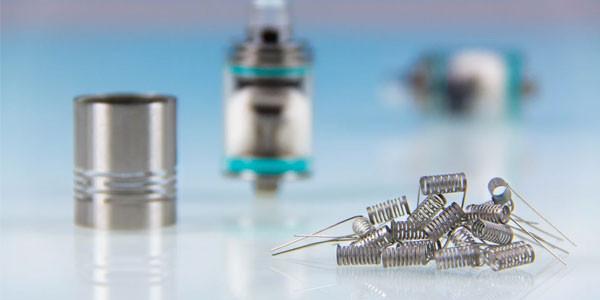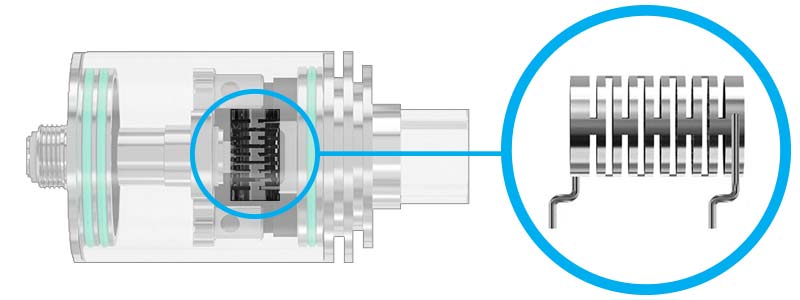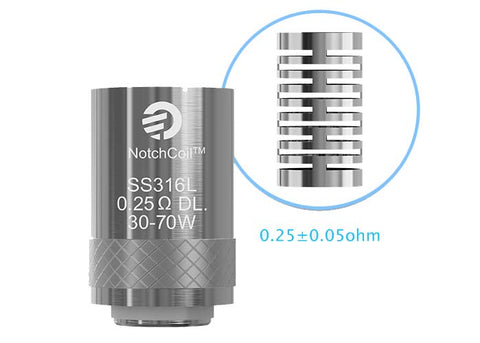
Tutorial: What is a Notchcoil? Overview, benefits and review.
After years of serious vaping, many of us became experts on the art of wrapping resistance wire around household objects to create a variety of different coils in every shape and size and gimmick. That seems like such a necessary skill, but looking back, it was bound to become obsolete eventually.
The NotchCoil from Jaybo wants you to believe that time has finally come. The company calls their new design revolutionary, and that’s not far off.
Unlike almost every other metal coil, the NotchCoil does not use wrapped wire at all. It’s made out of milled and cut steel plating, 316L stainless, allowing temp control or straight wattage power. The design was built to work in the Theorem tank, an interesting RTA in its own right, but they can also be purchased on their own and will fit in any RDA that will accept their impressive 5.5mm girth, just add cotton. If you run a Joyetech Cuboid Mini or Cubis setup, you can buy complete premade NotchCoil heads. That’s a smart move from Joyetech, jumping in early on this design. Prices are right in line with other pre-made coils on the market.
What’s so great about it? Jaybo promises everything your jaded heart desires, including perpetually burn-free hits, incredible flavor and vapor production, and unmatched durability. We found those claims to be a little exaggerated, but not by much. This is a great piece of tech.

Our first trial consisted of a NotchCoil set in its natural habitat, a Wismec Theorem. The smoothness immediately impressed everyone, and that smoothness would be a constant treat throughout testing. The Theorem holds less juice than most other tanks at 2ml, but the top-fed airflow design seemed especially well matched to the coil. Flavor is rich, although the claim that a NotchCoil produces as much flavor as a Clapton coil falls flat. It’s rich, but not that rich. Think of it as a single step below a Clapton or twisted wire build.
Next, the NotchCoil found its way into an RDA, namely a 25mm Goon. This taught us some lessons. First, when Jaybo says the coil is meant to run below 70 watts, they mean it. In fact, 70 watts is a bit much; a mild burning taste accompanies every draw. The single coil really belongs at 60 watts, and 50 watts gives up little in vapor production. Put two coils in, and 100 watts works beautifully.

That vapor production is very impressive. It’s not going to compete with a 20 gauge triple coil competition setup, but for everyday vaping, it absolutely rocks, because it gives you something which no other coil can match: efficiency. There’s a bit of physics at work here. You will notice that the NotchCoil is light, significantly lighter than a coil of similar diameter made with stainless wire. This is a good thing. Since the NotchCoil uses metal plate instead of wrapped wire, it can give you just as much surface area while having to heat significantly less mass. This saves you battery power, and means that a single NotchCoil produces very similar amounts of vapor as a typical hand-wrapped coil at about 80 watts. The drop from 80 watts to 60 watts means you can reduce your power consumption by a fourth, and your batteries will thank you for it. You could easily find yourself swapping those batteries out less often.
The NotchCoil never failed in any way, so we can’t argue with the reliability or consistency, either. Resistance was .24 ohm, a hundredth off of the .23 ohm the box advertises, and it never wavered, even as the coil was removed from one system and connected to another.
Great tech indeed. As a distinct product, the NotchCoil obviously works best in mid-power setups around that 50 to 60 watt mark, particularly with the Theorem tank. There are a lot of vapers looking for something like this, those who need consistently good performance with minimal hassle at a reasonable price point. They aren’t for the hardest hardcore cloud or flavor chasers, but that’s a niche market anyway. We wish the Theorem held more liquid, but it’s better to refill than to miss out on the excellent performance and expanded battery life you get using this setup.
As a concept, the NotchCoil design could be every bit as revolutionary as claimed as time goes on. You can easily imagine Jaybo expanding on the idea, creating 20 watt coils for beginners and 120 watt coils for cloud chasers that would waste the competition. The milled steel design makes unusual, high surface area shapes easy for mass production.
Right now, the biggest threat to this bright future is obviously the FDA. The NotchCoil design, like every other product destined for the vaping public, will have to undergo government testing to stay on the market after the new deeming regulations take full effect. Let’s hope that either those regulations get changed or that Jaybo can find a way to pay for the testing, because the NotchCoil gives a lot of future non-smokers a better, more accessible vaping experience.
Notchcoil Videos:




Leave a comment